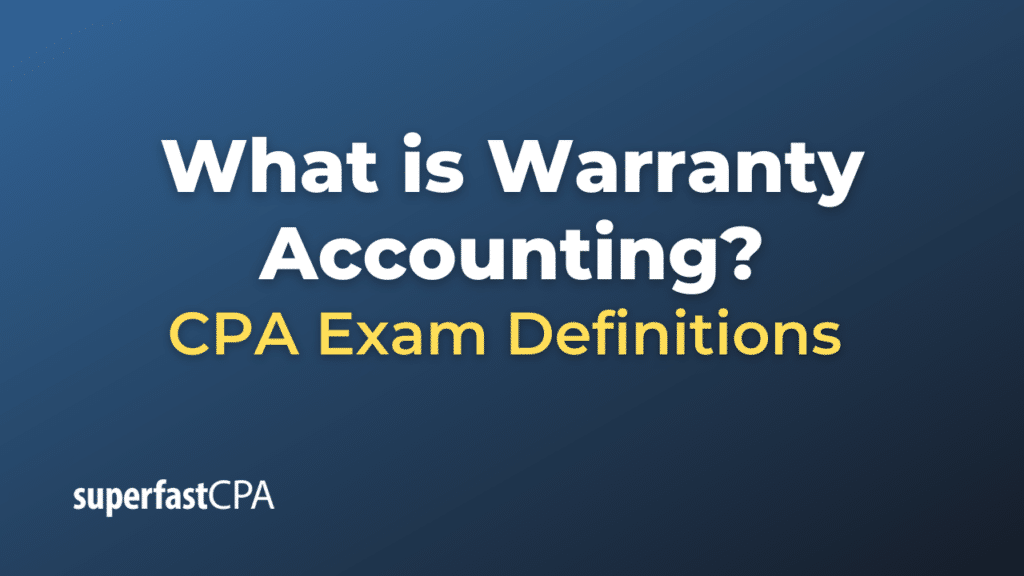Warranty Accounting
Warranty accounting refers to the accounting methods and practices used by companies to manage the financial implications of warranties they offer on their products or services. When a company sells a product with a warranty, it is committing to future costs for repairs, replacements, or refunds for defective or unsatisfactory products. Because these are future obligations, accounting standards require that a company recognize them in the financial statements at the time of the sale.
Here is how warranty accounting generally works:
Setting Up a Warranty Liability
- Estimate Future Warranty Costs: Based on historical data and other factors, a company estimates the expected costs of honoring the warranties for products sold during a given period.
- Create a Warranty Liability Account: When a sale is made, the company sets up a warranty liability account on the balance sheet to represent its estimated future obligations. This is a contra-account to either cost of goods sold or operating expenses, depending on the accounting policy of the company.
Journal Entries
Upon making a sale with a warranty, the initial journal entries might look like:
- Debit: Accounts Receivable or Cash (depending on payment)
- Credit: Sales Revenue
- Debit: Warranty Expense
- Credit: Warranty Liability
Honoring a Warranty
When the company actually incurs warranty costs (e.g., a customer returns a product for repair), it adjusts the warranty liability account.
Typical journal entries when honoring a warranty could be:
- Debit: Warranty Liability
- Credit: Inventory or Accounts Payable (for parts)
- Credit: Cash or Accounts Payable (for labor)
Revising Estimates
It’s possible that the initial estimates for warranty costs may need to be revised. Companies often review their warranty liability accounts periodically to make adjustments based on new information, such as an unexpected rate of product returns or defects.
Financial Reporting
Both the warranty expense and the remaining warranty liability must be reported in the company’s financial statements. This is critical for shareholders, creditors, and other stakeholders to accurately assess the company’s financial health and future obligations.
Warranty accounting ensures that a company responsibly accounts for the future costs associated with its warranty obligations, providing a more complete and accurate picture of its overall financial position. It’s governed by accounting standards such as the U.S. Generally Accepted Accounting Principles (GAAP) or International Financial Reporting Standards (IFRS), depending on the jurisdiction.
Example of Warranty Accounting
Let’s consider a simplified example involving a fictional company that manufactures and sells kitchen appliances. The company offers a one-year warranty on a specific model of blender, promising to repair or replace any units that have defects in materials or workmanship within the warranty period.
Scenario
- Initial Sales: The company sells 1,000 blenders during the month of January at $100 each. Based on past experience and statistical analysis, the company estimates that 5% of these blenders will be returned for repairs or replacements, with an average repair/replacement cost of $30 per unit.
- Warranty Liability Estimate:
- 1,000 blenders x 5% (estimated returns) = 50 blenders
- 50 blenders x $30 (estimated cost per repair/replacement) = $1,500
- Actual Warranty Costs: During February, 10 blenders are returned for repair or replacement, costing $25 each (totaling $250).
Accounting Entries
At the Time of Initial Sales in January
- Recognize Revenue:
- Debit: Accounts Receivable $100,000 (1,000 blenders x $100)
- Credit: Sales Revenue $100,000
- Establish Warranty Liability:
- Debit: Warranty Expense $1,500
- Credit: Warranty Liability $1,500
When Actual Warranty Costs Are Incurred in February
- Adjust Warranty Liability:
- Debit: Warranty Liability $250 (10 blenders x $25)
- Credit: Inventory or Accounts Payable $250
End-of-Month Adjustments
At the end of the month or quarter, the company may reassess its warranty liability based on actual experience and other relevant factors. Let’s say after February, the company revises its estimated repair cost to $27 per unit (instead of $30).
- New Warranty Liability Estimate:
- Remaining units under warranty: 1,000 – 10 = 990 blenders
- 990 blenders x 5% (estimated returns) = 49.5 (approximately 50 blenders)
- 50 blenders x $27 (new estimated cost per repair) = $1,350
- Adjust Warranty Liability:
- Debit: Warranty Expense $150 ($1,500 old estimate – $1,350 new estimate)
- Credit: Warranty Liability $150
This example simplifies many aspects of warranty accounting, but it demonstrates the key steps: estimating future warranty costs, establishing a warranty liability at the time of sale, and adjusting that liability as actual costs are incurred or as new information becomes available.













